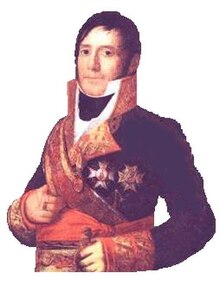Gabriel Mendizábal Yraeta
This article includes a list of general references, but it lacks sufficient corresponding inline citations. (August 2023) |

Gabriel María de Mendizábal Yraeta, 1st Count of Cuadro de Alba de Tormes (14 May 1765, in Bergara, Gipuzkoa – 1 September 1838, in Madrid) was a Spanish general officer. He fought in the Peninsular War, where he commanded the Spanish forces at the Battle of the Gebora.
Military career
His military career began as a sergeant major. His first action came during the War of the Pyrenees. Mendizábal fought on the Basque-Navarrese and Catalan fronts.
In 1793, he was promoted to the rank of colonel and was given command of a new regiment, the Voluntarios de Burgos posted to the north of
In 1802, Mendizábal was again promoted to the rank of colonel and given the command of a regiment of volunteers from Navarre. On 23 September 1804, he entered Bilbao at the head of his troops to put an end to a series of riots collectively known as the Zamacolada.[2]
In 1809, at the start of the Peninsular War, Mendizábal was promoted to mariscal de campo, a rank equivalent to major general. Later that year, he was granted the noble title of Count, officially Conde de Cuadro de Alba de Tormes, for his military achievements against the French cavalry. In 1810, he was promoted to lieutenant general.
He was named commander of the Army of the Left and suffered a defeat at the
. He fought in this mountainous region using guerrilla tactics.On 16 December 1812, Mendizábal was named political chief of the
Politics
Between 1814 and 1820, he gained political power as a member of the Consejo Supremo de la Guerra. In 1834, he was named president of the Tribunal Supremo de Guerra y Marina, a position he held until his death in 1838.[3]
References
- ^ Censo Guía, The Spanish Secretary of State of Culture.
- ^ biografía de Gabriel de Mendizábal Iraeta MCN Biografías.
- ^ Glosario de la Guerra de la Independencia, Archivo Histórico Nacional (Spanish Ministry of Culture)
